Abstract
Using antiferromagnets as active elements in spintronics requires the ability to manipulate and read-out the Néel vector orientation. Here we demonstrate for Mn2Au, a good conductor with a high ordering temperature suitable for applications, reproducible switching using current pulse generated bulk spin-orbit torques and read-out by magnetoresistance measurements. Reversible and consistent changes of the longitudinal resistance and planar Hall voltage of star-patterned epitaxial Mn2Au(001) thin films were generated by pulse current densities of ≃107 A/cm2. The symmetry of the torques agrees with theoretical predictions and a large read-out magnetoresistance effect of more than ≃6% is reproduced by ab initio transport calculations.
The zero net moment of antiferromagnets makes them insensitive to magnetic fields and enables ultrafast dynamics promising for novel spintronics. Here the authors achieved pulse current induced Néel vector switching in Mn2Au(001) epitaxial thin films, which is associated with a large magnetoresistive effect allowing simple read-out.
Introduction
Antiferromagnets (AFMs) are magnetically ordered materials which exhibit no net moment and thus are insensitive to magnetic fields. Antiferromagnetic spintronics1 aims to take advantage of this insensitivity for enhanced stability, while at the same time active manipulation up to the natural THz dynamic speeds of AFMs2 is possible, thus combining exceptional storage density and ultrafast switching. However, the active manipulation and read-out of the Néel vector (staggered moment) orientation is challenging. Recent predictions have opened up a path based on a new spin-orbit torque3, which couples directly to the Néel order parameter. This Néel spin-orbit torque was first experimentally demonstrated in a pioneering work using semimetallic CuMnAs4.
For the key application operations of reading and writing in AFMs, different approaches have been previously put forward. Initial experiments on spin-valve structures with an AFM as the active layer manipulated the Néel vector by an exchange-spring effect with a ferromagnet (FM) and read-out via tunneling-anisotropic magnetoresistance (T-AMR) measurements5. Other related experiments were based on the same effect6, or on a FM to AFM phase transition7. However, the most promising approach is to use current-induced spin-orbit torques for switching the Néel vector. It exhibits superior scaling and its counterpart in FMs is already established and considered among the most efficient switching mechanisms for memory applications8,9.
Only two compounds, CuMnAs and Mn2Au, are known to provide at room temperature the collinear commensurate antiferromagnetic order and specific crystal structure, which is predicted to result in the staggered spin accumulation in the sublattice structure, leading to bulk Néel spin-orbit torques allowing for current-induced switching of the Néel vector3.
Semimetallic CuMnAs was grown previously by molecular beam epitaxy (MBE) with a Néel temperature of ≃500 K10 and current-induced switching of these samples was recently demonstrated for the first time4,11. However, for spintronics applications the compound Mn2Au provides several advantages, as it is a good metallic conductor and does not contain toxic components. Furthermore, its magnetic ordering temperature is well above 1000 K12, providing the necessary thermal stability for applications. Mn2Au shows a simple antiferromagnetic structure with the collinear magnetic moments in the (001) plane12–14. Thin film samples were previously grown in (101) orientation by MBE15 and Fe/Mn2Au(101) bilayers showed AMR effects of up to 2.5% in a 14 T rotating magnetic field16.
While Mn2Au was the first compound for which current-induced internal staggered spin-orbit torques were predicted3, corresponding experimental evidence has been missing. Here we report current-induced Néel vector switching in Mn2Au(001) epitaxial thin films, which is easily read-out by a large AMR. We compare the experimental results with calculations of the AMR from ab initio theory, from which we conclude an extrinsic disorder related origin of the exceptionally large magnetoresistance.
Results
Mn2Au samples preparation
Our Al2O3(Substrate)/Ta(10 nm)/Mn2Au(75 nm)/Ta(3 nm) samples were prepared by radio frequency sputtering from a single stoichiometric target and structurally and magnetically characterized as described elsewhere17. By x-ray diffraction, we demonstrated that the Mn2Au thin films grow with the (001) axis perpendicular to the thin film surface. The in-plane orientation is given by the epitaxial relation with the Ta(001) buffer layer, which results in the [100] direction of the Mn2Au thin films aligned parallel to the [100] direction of the epitaxial Ta layer. These samples were patterned into a star structure as shown in Fig. 1a. This geometry allows for electric writing of the Néel vector orientation by pulsing currents along the two perpendicular directions and and for electric read-out by measuring either the transversal resistivity ρxy, i.e., the Planar Hall Effect (PHE), or the longitudinal resistivity ρlong, corresponding to the AMR of the samples. Depending on the in-plane orientation of the patterned structure, the pulse currents can be sent along different crystallographic directions, i.e., along [100] or along [110] (45° in-plane rotation of the star pattern, Fig. 1b–d).
Fig. 1.
Sample layout. a Star pattern used for the current-induced Néel vector manipulation experiments with current pulse directions and probing contacts for Planar Hall Effect (PHE) measurements indicated. b shows the crystal structure of Mn2Au with arbitrarily selected in-plane orientation of the magnetic moments. c shows the in-plane orientation of the epitaxial Mn2Au thin films, which corresponds to the star pattern shown in a. || [010] is expected to rotate the magnetic moments in the indicated directions. d 45° in-plane rotation of the star pattern. || [110] is expected to rotate the magnetic moments in the indicated directions
Relation of AMR and PHE
The AMR of a single domain sample is given by
| 1 |
where ρlong is longitudinal resistivity, ϕ is the angle between the Néel vector and current direction and [hkl] is the Néel vector orientation in the basis of the tetragonal conventional unit cell (Fig. 1b). The PHE usually observed in ferromagnetic materials scales with the AMR and shows a dependence on the angle ϕ given by18,19:
| 2 |
Thus also in AFMs, ρxy has its maximum value and changes sign if ϕ switches from +45° to −45°.
Switching and read-out
For technical reasons the applicable pulse length for switching was limited to a minimum of 1 ms. This allows us using an oscilloscope to monitor the time-dependent sample resistivity during the application of the current pulses (Fig. 2). By comparison with the temperature dependence of the resistivity of our Mn2Au thin films obtained from separate measurements, this allows to study the current pulse induced heating effects. As shown in Fig. 2, significant heating with local temperatures up to 300 °C is obtained for the highest possible current densities not resulting in sample destruction.
Fig. 2.
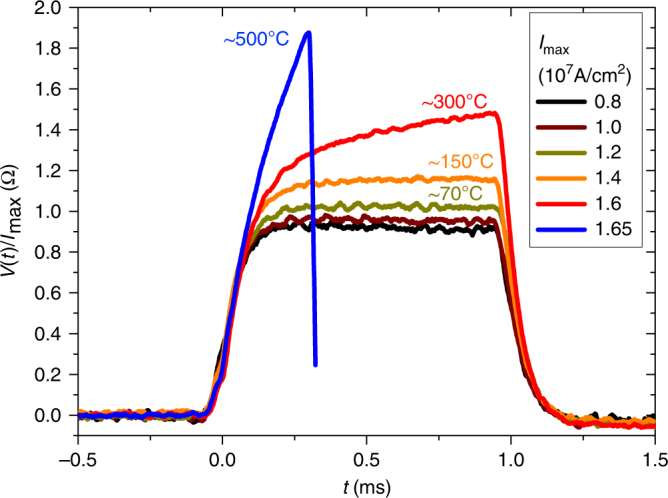
Current pulse induced heating. Time dependent normalized voltage V(t)/Imax measured between the contacts labled and during application of a current pulse with different maximum values Imax (Fig. 1). The current pulse induced temperature of our sample is estimated from a comparison with the Mn2Au temperature dependent resistivity R(T)17 extrapolated above room temperature
Current-induced Néel vector switching was only observed applying pulse current densities associated with notable heating. As single pulses resulted in very small changes of the read-out signals only, trains of 100 current pulses with a pulse length of 1 ms and a delay between the pulses of 10 ms were applied. This relatively long delay between the pulses was chosen to avoid the destruction of the sample by excessive accumulated heating. After a pulse train thermal relaxation on a time scale of 1 s was observed. Thus the read-out was performed with a delay of 10 s. The magnetic state of a sample probed this way is long-term stable, i.e., no changes of the read-out signals were observed within the probed time scales of up to 1 h.
Figure 3 shows the transversal resistivity ρxy versus the number of applied pulse trains. First, a pulse current density of 1.4 × 107 A/cm2 was applied along the [10] direction, resulting in a small change of the corresponding Hall voltage. Without reaching saturation after 50 pulse trains the pulse current direction was switched to [110], resulting in a reversal of the corresponding change of the transversal resistivity. This sequence could be reproduced several times. Increased pulse current densities of 1.7 × 107 and 1.8 × 107 A/cm2 resulted in larger changes of the corresponding Hall voltages. Those current densities are about 1 order of magnitude smaller than predicted by Železný et al.3,20, which could be related to thermal activation processes enabled by the above mentioned current pulse induced heating. By increasing the number of pulse trains applied along the [110] direction to 500, a trend towards saturation of the Hall voltage was obtained.
Fig. 3.
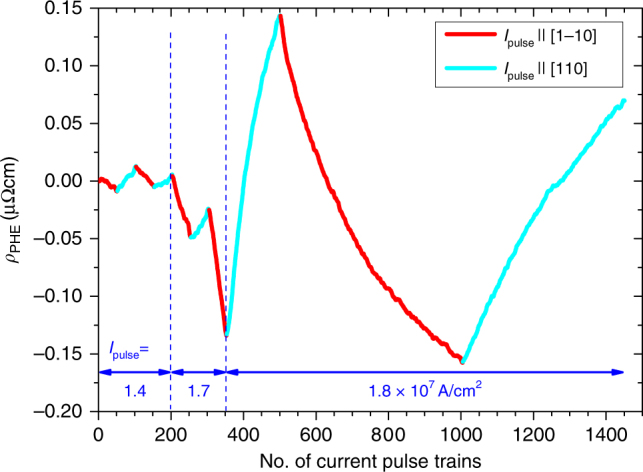
Transversal resistivity. Probed transversal resistivity (DC probing current density 104 A/cm2) vs. number of applied pulse trains along different directions. The crystallographic direction in which the current pulses were injected is indicated by the cyan and red color of the data points. The pulse current density was increased from 1.4 × 107 to 1.8 × 107 A/cm2 as indicated in the graph
Internal field like spin-orbit torques are expected to generate reversible switching between distinct stable states if the current is injected along biaxial easy directions3,21. However, we observed reversible switching to stable states for pulse currents along both the crystallographic [110] and [100] axes (rotated star pattern). Thus we conclude that the in-plane magnetic anisotropy of our Mn2Au thin films is weak. This is consistent with our calculations of the magnetocrystalline anisotropy energy (MAE), which is almost negligible within the (001) plane (Methods section).
An example of the resulting changes of the transversal and longitudinal resistivities generated by pulse currents along the [100] and [010] directions is displayed in Fig. 4. The inset of Fig. 4a shows that it is possible to apply current pulses until a large degree of saturation of the induced longitudinal resistivity changes is obtained. However, this is achieved for current densities that result for prolonged injection of pulses in the destruction of the samples. Thus to allow for an increased number of current pulse cycles with different polarities this regime has to be avoided. The current density at which eventually the sample is destroyed varies by a factor of ≃2 from sample to sample. The main upper panel (Fig. 4a) shows the longitudinal resistivity probed after each of the first 1600 pulse trains consisting of 100 pulses each with a current density 1.0 × 107 A/cm2. For the first sequences only small variations of the longitudinal resistivity were observed. However, with the application of subsequent pulse trains the magnitude of the effect increased. This training-like behaviour may be associated with the motion and pinning of AFM domain walls in the sample. After 1600 pulse trains a constant resistance change of % induced by 100 pulse trains was reached, which is an order of magnitude higher than what is observed for CuMnAs4.
Fig. 4.
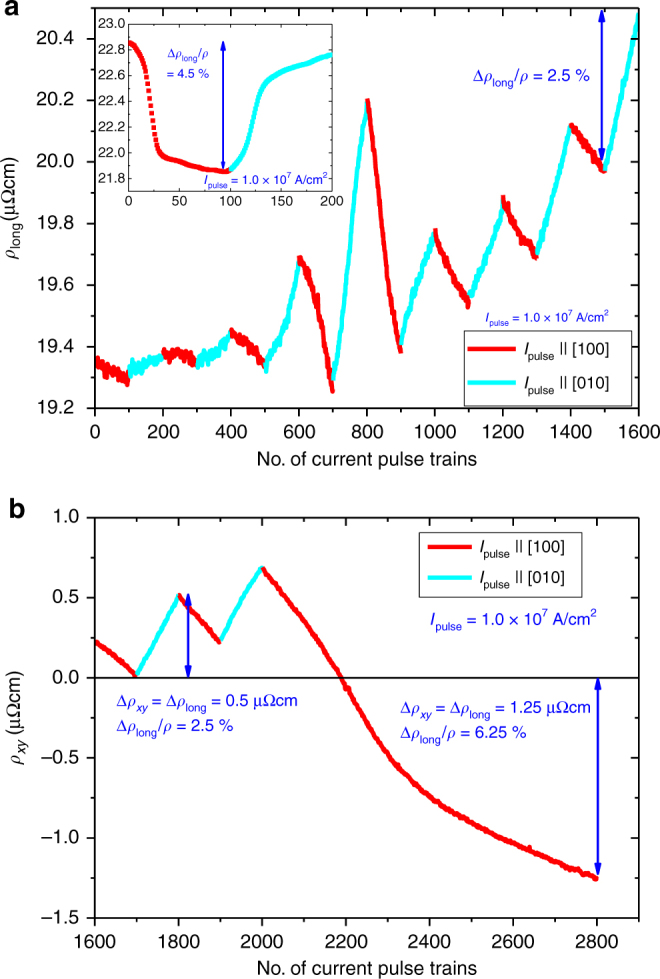
Longitudinal and transversal resistivities. a Longitudinal resistivity (DC probing current density 104 A/cm2) vs. number of applied pulse trains. The inset shows the longitinal resisitvity of another sample. In this case saturation of the magnetoresistance could be obtained for a few repetitions before the sample broke. b Transversal resistivity of the same sample as shown in the main panel of a vs. number of applied pulse trains. The crystallographic direction in which the current pulses were injected is indicated by the cyan and red color of the data points
To check the origin of these changes, the transversal resistivity of the sample was measured and also showed reproducible pulse current-induced changes (Fig. 4b). The increase of the transversal resistivity induced by 100 pulse trains amounted to ρxy = 0.5 μΩ cm.
Based on these numbers the identification of the longitudinal and transversal resistivities with the AMR and PHE can be verified: If both effects originate from the same anisotropic electron scattering, they have to be related by Eq. (2). We assume a switching of the Néel vector in parts of the sample corresponding to a change of ϕ in Eq. (2) from +45° to −45°, i.e.,
| 3 |
Thus we find that ρxy = 0.5 μΩ cm corresponds again to %. This consistency of the longitudinal and transversal resistivities provides strong evidence for an intrinsic electronic origin of the pulse current-induced changes of the magnetoresistance signals.
After two more pulse current direction reversals reproducing the previous behaviour of the sample, the pulse current direction was kept along [100] for 800 additional pulse trains. This resulted in a sign reversal of the PHE, which according to Eq. (2) corresponds also to a sign change of the angle ϕ between the Néel vector and the current direction. Although a small offset of the transversal voltage due to e. g. imperfections of the patterned structure is possible, the magnitude of the transversal voltage measured with both signs can only be explained by a switching of the Néel vector. As no saturation of the read-out signals without destroying the samples could be reached, we can conclude that ϕ was switched from +45° to −45° for the most part of the sample, but not everywhere. After about 300 pulse trains along the [100] direction a beginning saturation of the PHE resistivity appeared, but was not completed when after 500 additional pulse trains the sample broke. A maximum transversal resistivity of ρxy = 1.25 μΩ cm was reached, which based on Eq. (3) corresponds to an AMR of 6.25%. This is one of the largest AMR ratios found in metallic magnetic thin films, and its size bodes well for easy read-out of the antiferromagnetic state as necessary for device applications. While small variations exist between samples, we observe consistently larger AMR effects for pulse currents along the [100] than for the [110] directions.
Origin of the AMR
To understand the origin of the magnetoresistance effects, we calculated the AMR of single domain Mn2Au assuming a complete 90° switching of the Néel vector. In general, the AMR originates from effects of spin-orbit coupling on the band structure22 and from scattering from an extrinsic disorder potential23. Incorporating the effects of realistic disorder in the calculations, two types of disorder were considered: off-stoichiometry and inter-site swapping between Mn and Au atoms. Experimentally, the former was analyzed by energy dispersive x-ray spectroscopy (EDX) of 500 nm thick Mn2Au films resulting in a stoichiometry of 66.2 ± 0.3% Mn and 33.8 ± 0.3% Au, which indicates a slight Au excess. In addition, a small degree of inter-site disorder is to be expected, but its quantification is experimentally not accessible. Thus we simulated a slight excess of Au randomly distributed over the Mn sites and random Mn–Au swapping.
We calculated the AMR for two crystal directions of the Néel vector, AMR100 and AMR110 from ab initio theory. We employ the fully relativistic Dirac tight-binding linear-muffin tin orbital (FRD-TB-LMTO) density functional theory (DFT) combined with the Kubo-Greenwood formula for the longitudinal conductivity (see refs. 24–26):
| 4 |
where Vx,k is the velocity operator labeled by the Cartesian coordinate x, and wavenumber k, is the auxiliary Green function within the TB-LMTO formalism26, all evaluated at the Fermi level, denotes the configuration averaging in the presence of disorder, and v.c. are vertex corrections27. We treat the scattering in the chemicaly disordered Mn2Au within the coherent potential approximation (CPA). To reveal the role of the AMR contribution from spin-orbit coupling effects in the band structure, we also calculated the AMR of Mn2Au without chemical disorder in the constant relaxation time approximation (RTA) (see Methods section). The theoretical AMR is obtained by calculating the resistivity tensor ρ = σ−1 from Eq. (4) and substituting it into Eq. (1).
Figure 5a shows the AMR results obtained within the CPA for different degrees of disorder in Mn2Au. Large AMR values between 5 and 6%, which are consistent with our experiments, were obtained for Au excess generated scattering. Large AMR values consistent with our experiments were obtained for small degrees of disorder reaching a maximum value of 6.3% for 0.5% excess of Au. Moreover, we obtain AMR100 > AMR110, which reproduces the experimentally observed trend for the two crystalline directions. The corresponding calculated residual resistivities as shown in Fig. 5b are consistent with the experimentally obtained values (≃8 μΩ cm)17, corroborating the relevance of the simulated type of disorder.
Fig. 5.
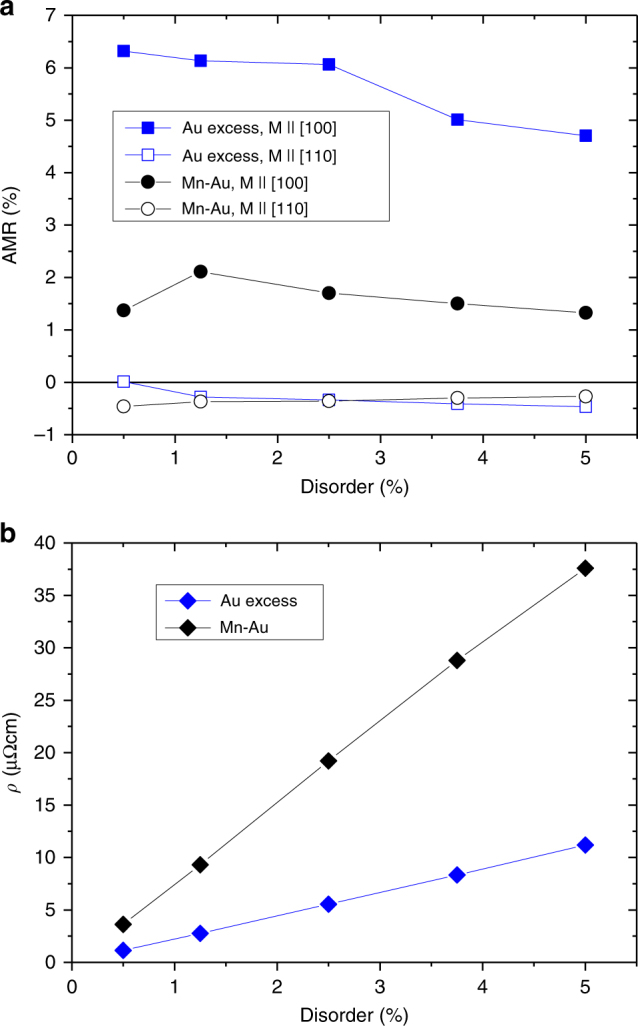
Calculated AMR. a Calculated AMR of Mn2Au for different degrees of disorder due to Au excess and due to Mn–Au site swapping with dependence on the Néel vector orientation. b Calculated residual resistivities of Mn2Au for different degrees disorder due to Au excess and due to Mn–Au site swapping
The two types of disorder have different effects on the density of states (DOS) calculated within the FRD-TB-LMTO+CPA24,26. In the case of the Mn–Au swapping disorder, Mn located at the Au sites creates a virtual bound states at the Fermi level as shown in Fig. 6a, which increases the resistivity (Fig. 5b). However, such states are not created by Au excess as shown in Fig. 6b. Thus these virtual bound states (VBS) are the dominating origin of the disorder induced resistivity increase but not of the large AMR. We note that the VBS are observed for the all simulated concentrations of Mn–Au swapping and for the sake of clarity we choose in Fig. 6 the largest simulated disorder strength since it leads to the better visibility of the VBS peak in the total density of states.
Fig. 6.
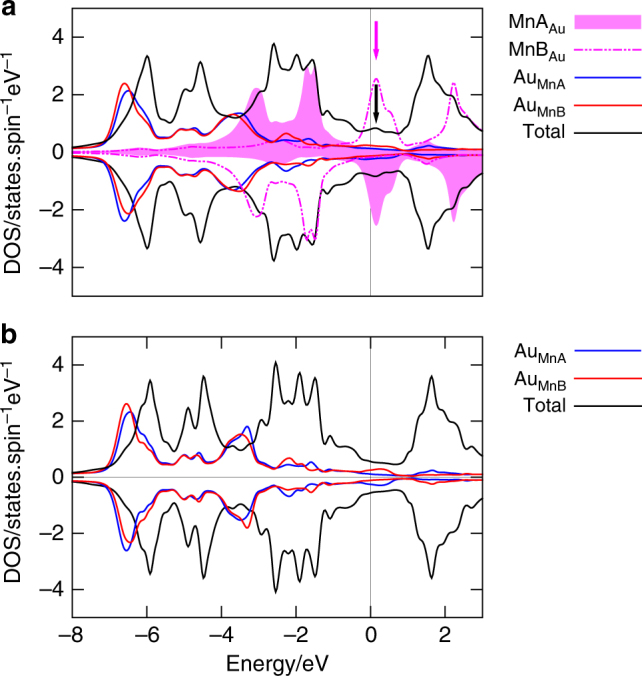
Atom and spin resolved DOS as calculated ab initio. a Total and disordered atom resolved DOS of Mn2Au with 5% Mn–Au swapping. The magenta (black) arrow marks the virtual bound state in the Mn on Au site (total) density of states. b DOS of Mn2Au with 5% excess of Au
Instead of considering a specific type of disorder, scattering can also be treated within the RTA by broadening the imaginary part of the complex energy Imz, which introduces unspecific lifetime effects on the electronic states, but otherwise keeps the band structure unperturbed by the disorder. With Imz ~ 13 meV we achieved a residual resistivity ≃10 μΩ cm, which corresponds to the experimental low temperature values. Within this approximation we obtained AMR100~1% and AMR110~0.1%. As these RTA values are significantly smaller than the CPA values, they indicate an extrinsic origin of the experimentally observed large AMR related to the Au excess on Mn sites as described by the CPA.
To further elucidate the effect of this Au excess on the electronic structure and related origin of the large scattering contribution to the AMR, we calculated the Bloch spectral function . Here the physical Green function is related to the auxiliary Green function in Eq. (4)26 and is calculated within the CPA along the high symmetry lines in the Brillouin zone of Mn2Au with 0.5% excess of Au. Since the vertex correction turned out to be negligible in Mn2Au with excess of Au, the Bloch spectral function represents an appropriate visualization of the disordered effects. As shown in Fig. 7 the spectral weight at the Fermi level along MΓ line increases when rotating the Néel vector from || [100] (Fig. 7a) to || [010] (Fig. 7b). This suggests that the sharper spectral weight in the direction parallel as compared to perpendicular to the current direction effectively increases the corresponding relaxation time and thus reduces the resistivity. Please note that this picture remains qualitatively unchanged also for higher degrees of disorder, which we explicitly verified for 5% Au excess. This together with the k-space anisotropy of the MΓ band around the Fermi level can explain the high value of AMR100 experimentally observed for Au-rich Mn2Au.
Fig. 7.
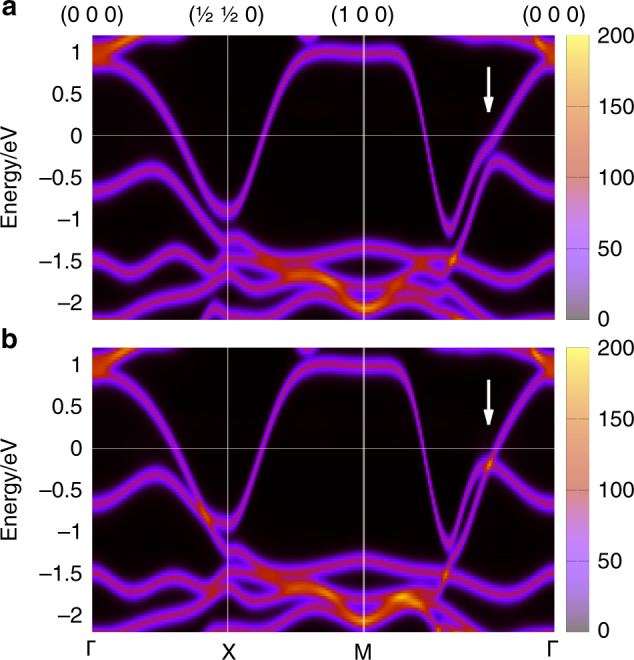
Bloch spectral function calculated within the CPA for 0.5%-Au-rich Mn2Au for two orientations of the Néel vector: a || [100] and b || [010]. The white arrows mark the major changes of the spectral function induced by the Néel vector rotation
Discussion
In-plane switching of the Néel vector in the antiferromagnetic metal Mn2Au by current pulses was realized using intrinsic spin-orbit torques. Consistent measurements of the AMR and PHE showed pulse current direction dependent reversible changes, providing direct evidence for Néel vector switching. Easy read-out of the switching is provided by a large amplitude of the AMR of more than 6%, which is more than an order of magnitude higher than previously observed for other antiferromagnetic systems and one of the highest AMR amplitudes found for metallic magnetic thin films. We can reproduce the magnitude of the effect theoretically by including realistic disorder and, in particular, find the same dependence of the amplitude on the crystallographic directions in the experiment as in the calculation. With the basic principles of writing and read-out demonstrated, combined with a theoretical understanding of the underlying spin-orbit torques, and the large magnetoresistive effects, the metallic compound Mn2Au is a prime candidate to enable future AFM spintronics.
Methods
MAE calculation
The MAE of chemically ordered Mn2Au was calculated using the FLAPW (full potential linearized augmented plane wave)+GGA (Generalized Gradiend Approximation) method in combination with the magnetic force theorem28. We found the in-plane MAE: ≲ μeV per formula unit. However, this method is suitable only for fully ordered crystal structures. Thus to realistically describe our experiments we calculated the MAE within the TB-LMTO+CPA also for disordered Mn2Au. For all concentrations of the simulated types of disorder we obtained the out-of-plane MAE ≃ 2.9 meV. The in-plane MAE calculation gives E[100] − E[110] from −1 to −3 μeV per formula unit at the resolution limit of our methods. While the out-of-plane MAE is similar to the reported value for chemically ordered Mn2Au29, the in-plane MAE of the disordered material has opposite sign. Independent from the sign the tiny value of the in-plane MAE at the resolution limit of the calculations is consistent with the experimental observation that by current switching the [100] as well as the [110] Néel vector orientation could be stabilized in disordered Mn2Au.
AMR calculation
To calculate the AMR of Mn2Au ab initio we employed the FRD-TB-LMTO+CPA method in combination with the Kubo formula24–26. s-type, p-type, and d-type orbitals were included in the basis and the LSDA (local spin density approximation) and the Vosko-Wilk-Nusair exchange-correlation potential parametrization30 were used. The ground-state magnetization and density of states was reproduced consistently with a previous report31. In the transport calculations we used up to 1010 k points in the Brillouin zone and for the CPA residual resistivity calculations we set the imaginary part of the complex energy to 0.13 meV. In the RTA, the imaginary part of the complex energy Imz in the Bloch spectral function An,k(z) was approximated by a finite isotropic k-independent relaxation time. In the CPA, the effective medium was constructed corresponding to a random averaging of the occupancies of the disordered sites. The CPA Bloch spectral function is anisotropic and k-dependent and determined by the effective medium potential.
We compared the RTA and the CPA derived calculated resistivities with the corresponding experimental values, from which we concluded that the level of disorder in our samples is at least 0.5%. Resistivity calculations for lower disorder values around, e.g., 0.1% correspond to 10–20 times smaller residual resistivities than observed in experiment and are thus not relevant in the framework of our manuscript. Nevertheless, we also calculated AMR100 for 0.1% of Au excess resulting in a value of (3.7 ± 1.5)%. The large error of this calculation is due to the increased number of iterations and k points needed for calculations with such a tiny degree of disorder.
Data availability
The relevant data are available within the article or from the authors on reasonable request.
Electronic supplementary material
Acknowledgements
This work is supported by the German Research Foundation (DFG) through the Transregional Collaborative Research Center SFB/TRR173 Spin+X, Projects A03 and A05. J.S., L.S., O.G., and T.J. acknowledge the support of the Alexander von Humboldt Foundation, the ERC Synergy Grant SC2 (No. 610115), the Ministry of Education of the Czech Republic Grant No. LM2015087, and the Grant Agency of the Czech Republic grant no. 14-37427G, L.S. acknowledges support from the Grant Agency of the Charles University, no. 280815. Access to computing and storage facilities owned by parties and projects contributing to the National Grid Infrastructure MetaCentrum provided under the program Projects of Large Research, Development, and Innovations Infrastructures (CESNET LM2015042), is greatly appreciated. This work was supported by The Ministry of Education, Youth and Sports from the Large Infrastructures for Research, Experimental Development and Innovations project IT4 Innovations National Supercomputing Center LM2015070. The work of I.T. was supported by the Czech Science Foundation (Grant No. 14-37427G).
Author contributions
S.Y.B. and M.J. mainly wrote the paper and performed the transport measurements; L.S. performed the AMR and anisotropy calculations and wrote the corresponding part of the manuscript, I.T. developed the codes for the transport calculations, S.Y.B. and A.A.S. prepared the samples, H.-J.E., M.K., O.G., T.J., I.T., and J.S. discussed the results and contributed to the writing of the manuscript; M.J. coordinated the project.
Competing interests
The authors declare no competing financial interests.
Footnotes
Electronic supplementary material
Supplementary Information accompanies this paper at 10.1038/s41467-017-02780-x.
Publisher's note: Springer Nature remains neutral with regard to jurisdictional claims in published maps and institutional affiliations.
References
- 1.Jungwirth T, Marti X, Wadley P, Wunderlich J. Antiferromagnetic spintronics. Nat. Nanotech. 2016;11:231–241. doi: 10.1038/nnano.2016.18. [DOI] [PubMed] [Google Scholar]
- 2.Kampfrath T, et al. Coherent terahertz control of antiferromagnetic spin waves. Nat. Photonics. 2011;5:31–34. doi: 10.1038/nphoton.2010.259. [DOI] [Google Scholar]
- 3.Železný J, et al. Relativistic Neel-order fields induced by electrical current in antiferromagnets. Phys. Rev. Lett. 2014;113:157201. doi: 10.1103/PhysRevLett.113.157201. [DOI] [PubMed] [Google Scholar]
- 4.Wadley P, et al. Electrical switching of an antiferromagnet. Science. 2016;351:587–590. doi: 10.1126/science.aab1031. [DOI] [PubMed] [Google Scholar]
- 5.Park BG, et al. A spin-valve-like magnetoresistance of an antiferromagnet-based tunnel junction. Nat. Mater. 2011;10:347–351. doi: 10.1038/nmat2983. [DOI] [PubMed] [Google Scholar]
- 6.Fina I, et al. Anisotropic magnetoresistance in an antiferromagnetic semiconductor. Nat. Commun. 2014;5:4671. doi: 10.1038/ncomms5671. [DOI] [PubMed] [Google Scholar]
- 7.Marti X, et al. Room-temperature antiferromagnetic memory resistor. Nat. Mater. 2014;13:367–374. doi: 10.1038/nmat3861. [DOI] [PubMed] [Google Scholar]
- 8.Gambardella P, Miron IM. Current-induced spin-orbit torques. Philos. Trans. R. Soc. A. 2011;369:3175–3197. doi: 10.1098/rsta.2010.0336. [DOI] [PubMed] [Google Scholar]
- 9.Brataas A, Hals KMD. Spin-orbit torques in action. Nat. Nanotech. 2014;9:86–88. doi: 10.1038/nnano.2014.8. [DOI] [PubMed] [Google Scholar]
- 10.Wadley P, et al. Tetragonal phase of epitaxial room-temperature antiferromagnet CuMnAs. Nat. Commun. 2013;4:2322. doi: 10.1038/ncomms3322. [DOI] [PubMed] [Google Scholar]
- 11.Grzybowski MJ, et al. Imaging current-induced switching of antiferromagnetic domains in CuMnAs. Phys. Rev. Lett. 2017;118:057701. doi: 10.1103/PhysRevLett.118.057701. [DOI] [PubMed] [Google Scholar]
- 12.Barthem VMTS, Colin CV, Mayaffre H, Julien MH, Givord D. Revealing the properties of Mn2Au for antiferromagnetic spintronics. Nat. Commun. 2013;4:2892. doi: 10.1038/ncomms3892. [DOI] [PubMed] [Google Scholar]
- 13.Shick AB, Khmelevskyi S, Mryasov ON, Wunderlich J, Jungwirth T. Spin-orbit coupling induced anisotropy effects in bimetallic antiferromagnets: A route towards antiferromagnetic spintronics. Phys. Rev. B. 2010;81:212409. doi: 10.1103/PhysRevB.81.212409. [DOI] [Google Scholar]
- 14.Barthem VMTS, et al. Easy moment direction and antiferromagnetic domain wall motion in Mn2Au. J. Magn. Magn. Mater. 2016;406:289–292. doi: 10.1016/j.jmmm.2015.07.101. [DOI] [Google Scholar]
- 15.Han-Chun W, et al. Mn2Au: body-centered-tetragonal bimetallic antiferromagnets grown by molecular beam epitaxy. Adv. Mat. 2012;24:6374–6379. doi: 10.1002/adma.201202273. [DOI] [PubMed] [Google Scholar]
- 16.Han-Chun W, et al. Anomalous anisotropic magnetoresistance of antiferromagnetic epitaxial bimetallic films: Mn2Au and Mn2Au/Fe bilayers. Adv. Funct. Mat. 2016;26:5884–5892. doi: 10.1002/adfm.201601348. [DOI] [Google Scholar]
- 17.Jourdan M, et al. Epitaxial Mn2Au thin films for antiferromagnetic spintronics. J. Phys. D. 2015;48:385001. doi: 10.1088/0022-3727/48/38/385001. [DOI] [Google Scholar]
- 18.Thompson DA, Romankiw LT, Mayadas AF. Thin film magnetoresistors in memory, storage, and related applications. IEEE Trans. Magn. 1975;11:1039–1050. doi: 10.1109/TMAG.1975.1058786. [DOI] [Google Scholar]
- 19.Seemann KM, et al. Origin of the planar Hall effect in nanocrystalline Co60Fe20B20. Phys. Rev. Lett. 2011;107:086603. doi: 10.1103/PhysRevLett.107.086603. [DOI] [PubMed] [Google Scholar]
- 20.Železný J, et al. Spin-orbit torques in locally and globally noncentrosymmetric crystals: Antiferromagnets and ferromagnets. Phys. Rev. B. 2017;95:014403. doi: 10.1103/PhysRevB.95.014403. [DOI] [Google Scholar]
- 21.Roy PE, Otxoa RM, Wunderlich J. Robust picosecond writing of a layered antiferromagnet by staggered spin-orbit fields. Phys. Rev. B. 2016;94:014439. doi: 10.1103/PhysRevB.94.014439. [DOI] [Google Scholar]
- 22.Šmejkal L, Železný J, Sinova J, Jungwirth T. Electric control of dirac quasiparticles by spin-orbit torque in an antiferromagnet. Phys. Rev. Lett. 2017;118:106402. doi: 10.1103/PhysRevLett.118.106402. [DOI] [PubMed] [Google Scholar]
- 23.De Ranieri E, et al. Lithographically and electrically controlled strain effects on anisotropic magnetoresistance in (Ga,Mn)As. New. J. Phys. 2008;10:065003. doi: 10.1088/1367-2630/10/6/065003. [DOI] [Google Scholar]
- 24.Turek I, Kudrnovsky J, Drchal V. Ab initio theory of galvanomagnetic phenomena in ferromagnetic metals and disordered alloys. Phys. Rev. B. 2012;86:014405. doi: 10.1103/PhysRevB.86.014405. [DOI] [Google Scholar]
- 25.Turek I, Kudrnovsky J, Drchal V. Fermi sea term in the relativistic linear muffn-tin-orbital transport theory for random alloys. Phys. Rev. B. 2014;89:064405. doi: 10.1103/PhysRevB.89.064405. [DOI] [Google Scholar]
- 26.Turek I, Kudrnovsky J, Drchal V, Szunyogh L, Weinberger P. Interatomic electron transport by semiempirical and ab initio tight-binding approaches. Phys. Rev. B. 2002;65:125101. doi: 10.1103/PhysRevB.65.125101. [DOI] [Google Scholar]
- 27.Carva K, Turek I, Kudrnovský J, Bengone O. Disordered magnetic multilayers: Electron transport within the coherent potential approximation. Phys. Rev. B. 2006;73:144421. doi: 10.1103/PhysRevB.73.144421. [DOI] [Google Scholar]
- 28.FLEUR: The Jülich FLAPW code family. Available at: www.flapw.de (2017).
- 29.Shick AB, Khmelevskyi S, Mryasov ON, Wunderlich J, Jungwirth T. Spin-orbit coupling induced anisotropy effects in bimetallic antiferromagnets: A route towards antiferromagnetic spintronics. Phys. Rev. B. 2010;81:212409. doi: 10.1103/PhysRevB.81.212409. [DOI] [Google Scholar]
- 30.Vosko SH, Wilk L, Nusair M. Accurate spin-dependent electron liquid correlation energies for local spin density calculations: a critical analysis. Can. J. Phys. 1980;58:1200–1211. doi: 10.1139/p80-159. [DOI] [Google Scholar]
- 31.Khmelevskyi S, Mohn P. Layered antiferromagnetism with high Neel temperature in the intermetallic compound Mn2Au. Appl. Phys. Lett. 2008;93:162503. doi: 10.1063/1.3003878. [DOI] [Google Scholar]
Associated Data
This section collects any data citations, data availability statements, or supplementary materials included in this article.
Supplementary Materials
Data Availability Statement
The relevant data are available within the article or from the authors on reasonable request.



